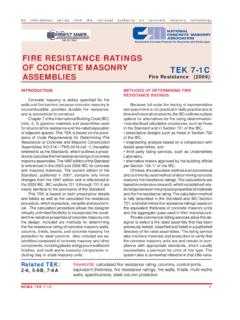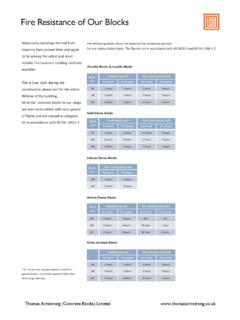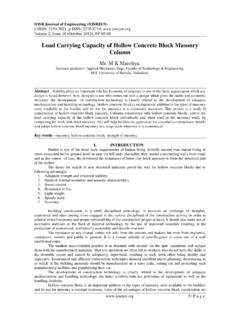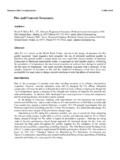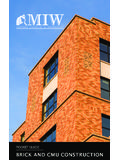Transcription of Advantages of Concrete Masonry - …
1 Advantages of Concrete Masonry You only have to look at the Egyptian pyramids or Greek temples still standing to realize the permanence and enduring beauty of Masonry construction. Building with Concrete is not new this construction method has been used for residential construction in Europe for centuries because of its strength and durability. But Masonry framing has been slow to appear in this area because of the availability of relatively inexpensive softwood lumber. In the past decade, the Carolinas have experienced several weather-related disasters, resulting in safety and security becoming increasingly more important when families look to build a new home.
2 Building a Concrete Masonry framed home costs about five percent more than a conventionally wood framed house, but the homeowners enjoy a safe haven in addition to significant lifetime savings such as lower utility bills, reduced insurance costs and lower home maintenance costs. " Concrete Masonry construction offers many Advantages in terms of termite resistance, thermal mass, sound attenuation, and fire resistance," says Professor J. Patrick Rand, AIA, School of Architecture at State. Beauty Is Much More Than Skin Deep To understand the difference between wood framing and Concrete Masonry framing (also referred to as c/m framing or block construction), we first need to define framing as simply the structural elements of a building.
3 Therefore, wood framing denotes a building made of wood such as 2x4's, over which brick veneer or other Masonry may be applied. However, this Masonry veneer is solely for aesthetic cladding and is not structural. On the other hand, Concrete Masonry framing uses readily available Concrete building blocks, typically 8 x8 x16 , for the structural exterior walls of the building. As with wood framing, c/m framing can be covered with brick, stucco, stone or siding after the exterior walls are erected. Let's now look at the Masonry construction technique itself.
4 Footings are dug and poured, with vertical rebar typically placed at four feet on center to tie the entire house together from the roof down to the footings. After the footings are poured, 12 Concrete Masonry units (CMUs) are laid for the foundation and the first and second floor exterior walls are then erected using 8 CMUs. Vertical columns are reinforced with rebar and then grouted solid for structural integrity at all point loads, on both sides of all window and door openings, and at four feet on center around the perimeter of the home.
5 Vertical cells in the Concrete block walls that are not grouted are filled with foam insulation. At both the first and second floor ceiling heights, a bond beam (a U-shaped Concrete block filled with Concrete and steel reinforcement) is installed to support the floor assemblies. Once the exterior Masonry walls are completed, the framing contractor then arrives at the jobsite to install the wood framing members. Floor ceiling systems are then installed by bolting a pressure-treated wood band to each of the bond beams. Joists are then installed using metal hangers attached to the wood band.
6 To install roof rafters, the framing contractor bolts another treated band to the top bond beam and then attaches rafters to this band that serves as a rafter plate. The interior of c/m framed walls can be finished in several ways. The simplest and least expensive method is to apply stucco finish directly to the block; however, the block walls do not have the same finish as other drywall surfaces in the home. To achieve a consistent appearance with drywall on all interior walls, some additional framing must be done. The framing contractor attaches treated 1x4 strips horizontally at the floor and ceiling and then 1x2 strips vertically at sixteen inches on center to facilitate drywall installation.
7 The cavity created by using this furring method allows the electrician to run wires without having to pull them through the Masonry walls. In areas where plumbing lines must be run in exterior walls, the framing contractor installs 2x4 studs in lieu of 1x4. strips at sixteen inches on center. Once the mechanicals are installed, the Masonry walls can then be covered with drywall and finished just like the other walls in the home. Standing Strong Currently over 80% of all single-family residences being built in Florida are utilizing c/m construction.
8 But when asked to imagine a block home, many people think of the 1950's and 1960's c/m framed houses--cold, damp boxes completed devoid of design flexibility and architectural appeal. However, unlimited architectural details can be achieved with stucco or other veneer applications over structural Masonry framing. The Facts - Masonry framing is vastly superior to wood framing in several respects. Concrete Masonry framing offers the ultimate in safety, strength, durability and habitability: Resistance to hurricanes, tornadoes and other weather-related phenomena since the entire structure is tied together from the footings to the roof assembly with steel reinforcement.
9 Achieving a a natural strength of 400 pounds per running foot compared to just 80 pounds for wood framing Resistance to fire and termites Resistance to sound transmission from traffic and other noise sources--the sheer mass and weight of Concrete Masonry walls can reduce sound penetrating through a wall by over 80 percent when compared to wood-frame construction. Lower homeowner maintenance costs since Masonry won't rot, peel or flake A reduction in energy bills of 40-60% compared to wood-frame homes Savings of up to 25% on homeowners insurance premiums and Is environmentally friendly since Concrete block is made from recycled materials.
10 Safe Rooms While Concrete Masonry homes are much more resistant to wind and other weather-related disasters compared to wood-framed homes, an additional safety precaution can be taken to protect your family. The best way is with a safe room a fully enclosed Concrete Masonry room that will help protect you and your family from injury or death due to the dangerous forces of high winds and tornadoes. The Wind Engineering Research Center at Texas Tech University and the Federal Emergency Management Agency developed safe room specifications to ensure consistent construction standards are met across the United States.

